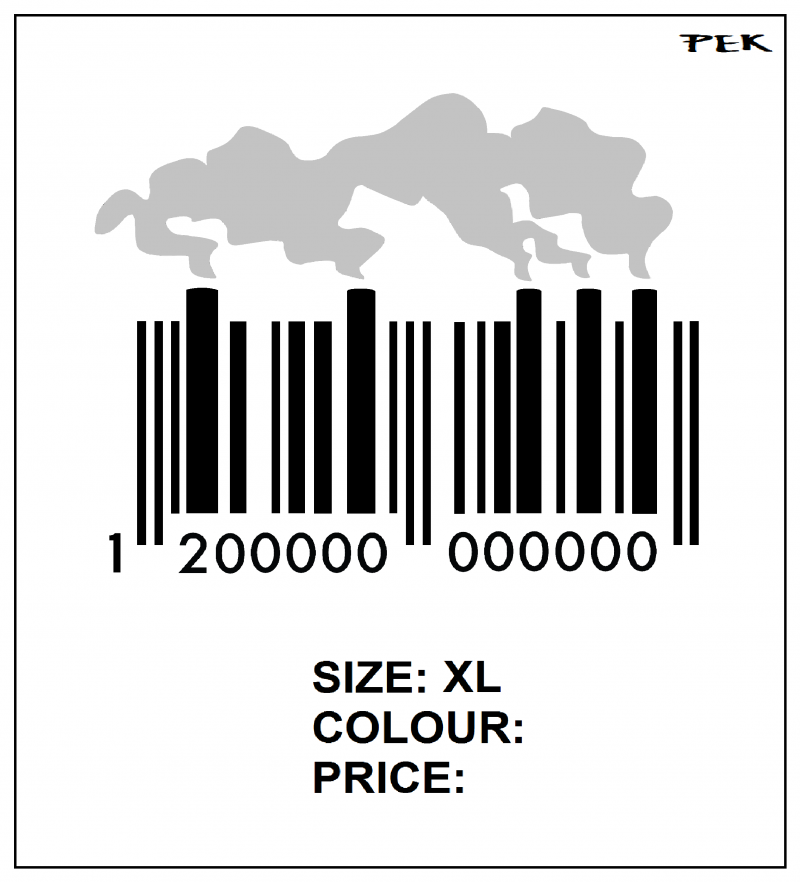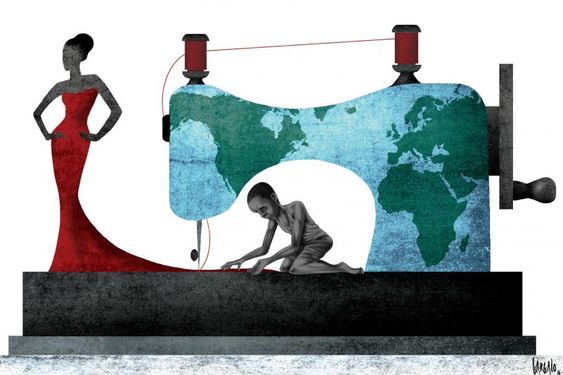Cover artwork by @gabriellastreet.art
Have you ever thought how much a T-shirt that you are buying costs? I mean not the price tag, but how much does it really cost? Or how many people worked for you to purchase this specific item? Or how much does it “cost” to the environment?
You may have heard the term “fast fashion”. But do you really know what it is? Do you know the impacts that it has in the environment?
Nowadays, fast fashion is on the spotlight due to constant environmental consequences and wastes that it produces. Fast fashion refers to mass production, inexpensive manufacturing, short-lived garment use, frequent consumption, and readily available fashion of today (Bick et al., 2018; Niinimäki et al., 2020). In other words, the word “fast” describes how quickly retailers can move the designs from the runways across the world to the stores each season, so as to capture the latest trends. Due to globalization the production of fast fashion is usually outsourced to low and middle-income countries.
Historically, it originated in the U.S.A. during the 1980s (Cortez et al., 2014). During 1990s and 2000s , fast fashion became a booming industry all over the world, strengthening a sense of consumerism. The stores initiated a feeling of urgency for consumers so as to purchase clothing either because they were so cheap that they could easily be disposed and purchase another piece of clothing or because fashion trends constantly change, and you should keep up with the trends. What is interesting is that fast fashion brands rarely advertised their products through conventional media (i.e., television, radio etc.). Instead they promote them through their store windows.
The basic problem with the fast fashion model is that it encourages consumers to view clothing as disposable. Hence, it promotes the rationale of “more for less”.
Fast fashion and environmental hazards
While the environmental pollution from the industry is troubling, the industry continues to grow. Specifically, it is the second largest industrial polluter after aviation, accounting for up to 10% of global pollution. Polyester, a material used extensively in clothing, derives from fossil fuels and sheds into microfibers and microplastics polluting the oceans. Microfibers cannot be extracted from water due to their small size.
Concerning water use, according to the World Bank (2019) every year the fashion industry uses 93 billion cubic meters of water — enough to meet the consumption needs of five million people. Mostly, the water use concerns cotton cultivation and the wet processes of textile manufacturing (bleaching, dyeing, printing and finishing) (Niinimäki et al., 2020). Besides water use that leads to scarcity, the industry pollutes local ecosystems since some chemicals used during manufacturing are toxic and end up in the groundwater.
The manufacturing process uses over 15.000 different chemicals (Roos et al., 2019). Moreover, in order to produce cotton, pesticides and land use are required, leading to additional environmental burden. Since the clothes are produced in developing countries, the transfer to the developed countries for consumption releases additional greenhouse gases. Textile wastes are dramatically increased due to the upbringing of fast fashion. There are two types of textile wastes: pre-consumer and post-consumer wastes (Niinimäki et al., 2020). The former refers to the production wastes, while the latter includes the clothes discarded by the consumers.
Due to the fact that most fast fashion clothes are produced in developing countries, the data concerning manufacture protocols, the raw materials used, and the safety of the materials are usually either limited or not available.

Polyester, a synthetic textile, is derived from oil, while cotton requires large amounts of water and pesticides to grow. Textile dyeing results in additional hazards as untreated wastewater from dyes are often discharged into local water systems, releasing heavy metals and other toxicants that can adversely impact the health of animals in addition to nearby residents (Bick et al., 2018).
Fast fashion and environmental justice
Now that environmental justice is defined, let’s see how fast fashion is merely and environmental justice issue. As mentioned above, due to globalization the production of inexpensive and readily available garments is outsourced to low and middle-income countries. Consequently, developing countries (i.e., the countries who largely produce the textiles) bear the burden of the environmental consequences of the developed countries (i.e., the countries who largely consume the textiles) derived from fast fashion. Additionally, since the wastes of the industry are disposed either in or near communities of colour or again outsourced in low and middle-income countries (Bick et al., 2018). Furthermore, textile workers, usually women in developing countries, are paid insufficient wages and forced to work long hours in appalling conditions (UNEP, 2018)2. Lastly, the use of chemicals in the textile production is harmful for the workers, the local communities as well as for the consumers themselves.
Fast fashion isn’t free. Someone, somewhere, is paying.
Lucy Siegle

Fast fashion in numbers
- It takes 7,500 litres of water to make a single pair of jeans, equivalent to the amount of water the average person drinks over a period of seven years. This means that around 215 trillion liters of water per year are consumed by the industry (UNEP, 2018) .
- The industry is responsible for an estimated 2-8% of the world’s greenhouse gas emissions (UNEP, 2018).
- Every second, the equivalent of one garbage truck of textiles is landfilled or burned. If nothing changes, by 2050 the fashion industry will use up a quarter of the world’s carbon budget (UNEP, 2019).
- Textiles are estimated to account for approximately 9% of annual microplastic losses to the ocean (UNEP, 2019) . To put that in numbers that is equal to half a million tons of plastic microfibers that are dumped into the ocean, the equivalent of 50 billion plastic bottles. Microfibers cannot be extracted from the water, and they can spread throughout the food chain (World Bank, 2019).
- About 60 per cent of material made into clothing is plastic, which includes polyester, acrylic and nylon textiles (UNEP, 2019).
- Every year the fashion industry uses 93 billion cubic meters of water — enough to meet the consumption needs of five million people (World Bank, 2019).
How can you spot if something is fast fashion
Fast fashion is everywhere, and it is easily spot. Firstly, check the price tag. Is the price extremely low? Secondly, check the tag of the specific garment. Are the production materials cheap and low quality that will last only a few wears? Is this specific piece of clothing made in developing countries? Thirdly, you can check the brand. Are styles from this specific brand cheaply made versions of trends from recent fashion shows? Are there every week new designs and mass production? You can check whether there are certifications. Fast fashion brands usually don’t display any certifications. Lastly, you can type on an internet browser “is … fast fashion?”. Be careful of brands that use greenwashing as a marketing strategy, trying to appear environmentally friendly.
“It’s only one cheap T-shirt”…said 8 billion people.
References
Bick, R., Halsey, E., & Ekenga, C. C. (2018). The global environmental injustice of fast fashion. Environmental Health, 17(1), 1-4.
Cortez, M. A., Tu, N. T., Van Anh, D., Ng, B. Z., & Vegafria, E. (2014). Fast fashion quadrangle: An analysis. Academy of Marketing Studies Journal, 18(1), 1.
Niinimäki, K., Peters, G., Dahlbo, H., Perry, P., Rissanen, T., & Gwilt, A. (2020). The environmental price of fast fashion. Nature Reviews Earth & Environment, 1(4), 189-200.
Roos, S., Jönsson, C., Posner, S., Arvidsson, R., & Svanström, M. (2019). An inventory framework for inclusion of textile chemicals in life cycle assessment. The International Journal of Life Cycle Assessment, 24(5), 838-847.
